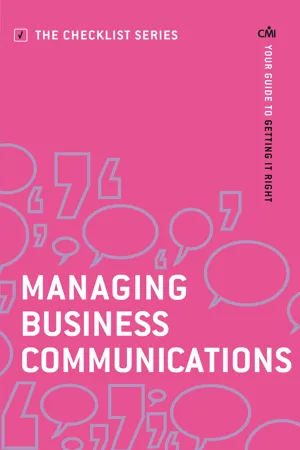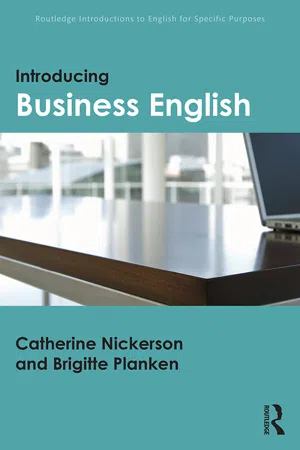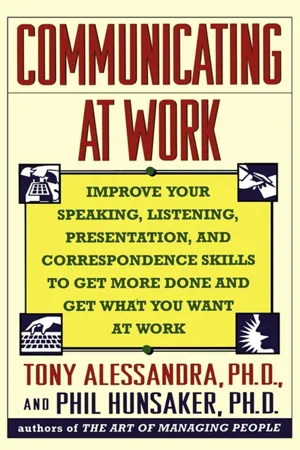Business
Written Communication
Written communication in business refers to the exchange of information, ideas, and messages through written documents such as emails, reports, memos, and letters. It is essential for conveying formal communication, documenting agreements, and maintaining records. Effective written communication is clear, concise, and professional, contributing to successful business operations and relationships.
Written by Perlego with AI-assistance
Related key terms
10 Key excerpts on "Written Communication"
- eBook - ePub
Managing Business Communications
Your Guide to Getting it Right
- Chartered Management Institute(Author)
- 2015(Publication Date)
- Profile Books(Publisher)
Effective business writingBusiness writing covers all forms of Written Communication in a workplace context, both electronic and paper-based. These include letters, memos, emails, public relations or marketing copy, contributions to social-media forums, brochures, web pages, newsletters, instruction manuals and reports.Many different forms of Written Communication are used in the workplace, but the need to get the right message across to the right people at the right time is common to them all. If a communication is unnecessarily lengthy, confusing or difficult to understand, the chances are that readers will either fail to read it or, if they do read it, will fail to grasp the implications. This damages the ability of the organisation to operate effectively and could result in bad decisions, dissatisfied customers, lost sales or a failure to take advantage of new opportunities. This checklist focuses on documents such as reports or proposals, but it also provides an introduction to the basic principles that apply to all forms of business writing. It aims to help writers get the attention of their audience and communicate clearly and concisely.Business writing should aim to inform, educate, interest, guide, motivate and influence the reader. This is achieved by explaining the aims and objectives of the communication, including facts, information and data, presenting findings and conclusions, making recommendations and proposing the next steps to take.Action checklist1 Be clear about your aims and objectivesStart by thinking about what you want to achieve; otherwise you will have no way of judging whether your communication has been successful. Make sure that you take the broader organisational context into account. Decide what you want to happen as a result of your communication. Do you want to impart facts or provoke a response? If you are expecting recipients to take action, make sure that you are explicit about what you expect or would like them to do. The communication should clearly state the aims and objectives from the outset in order to set the scene. Whatever form your writing takes, it should be appropriate to its purpose and its audience. - eBook - ePub
- Almut Koester(Author)
- 2004(Publication Date)
- Routledge(Publisher)
It may also be important to have written records for legal reasons, in case there is some dispute about agreements reached or work carried out. Written Communication: letters, fax and email The business letter is the traditional mode of Written Communication in the world of work. But nowadays the fax, and more recently email, have taken over as the most common form of exchanging written messages. The obvious advantage of fax and email is that the exchange of messages is almost instantaneous. However, this does not mean that the business letter has become obsolete. Business letters are still preferred for certain types of correspondence. In this unit, we are going to look at a series of letters and emails from the world of publishing. The correspondence is between a publisher, Language Publications 1 and a freelance writer, Alison Christy, who is reviewing the pilot edition of a new book, English the Easy Way, for the publisher. For textbooks intended to be used for teaching, in particular language teaching, it is common practice first to write a ‘pilot edition’ which is sent out to independent reviewers (usually teachers) for evaluation and is sometimes tested in actual classrooms. The first part of Text 8: Pilot Edition shows the beginning and end of a letter from the editor, Christine Warner, to the reviewer giving details about the book and instructions for the review - eBook - ePub
- Lauren Sergy(Author)
- 2017(Publication Date)
- Visible Ink Press(Publisher)
EFFECTIVE Written Communication COMMON TYPES OFWritten Communication What are letters?Letters are a form of written correspondence that directly addresses a person or organization. Informal letters may follow any sort of format and be any length. Formal or professional letters of correspondence typically feature the addresses of both the sender and the recipient, the date the letter was written, a salutation, the body or main content of the letter, a sign-off, and the signature of the writer or representative. Packages of documents, such as a contract or report, are often accompanied by an introductory or summary letter to the recipient.Letters may be sent in hard-copy format or as emails. As email has become the prevalent form of Written Communication, certain kinds of hard-copy letters have risen in status. Sending handwritten letters to someone in the mail is considered to be a particularly intimate form of correspondence. Letters containing formal acclamations, official notices, or legal documents are frequently sent by post and may be announced with an email.What are emails?Emails are digital messages containing text, pictures, media, or file attachments sent between two recipients through an online connection. For many people, emails are the form of Written Communication they will use most frequently. For a thorough review on email and its uses, conventions, and other matters, refer to the chapter on “The Email Minefield.”Are letters and emails treated the same?While the function of letters and emails are often similar, letters (aside from mass mailings and advertisements) often have a more intimate or formal feel than emails. Letters have also become a way to attract attention and increase the likelihood that a piece of correspondence will be read, especially in business-to-business transactions. The overwhelming quantity of emails people receive from day to day makes it easy for a message to be overlooked. As use of hard-copy letters and regular post have decreased, letters now stand out as an attention-grabbing form of communication. - eBook - ePub
Connecting Through Leadership
The Promise of Precise and Effective Communication in Schools (An educator’s guide to improving verbal and written communication skills)
- Jasmine K. Kullar(Author)
- 2019(Publication Date)
- Solution Tree Press(Publisher)
Written Communication is also not great for communicating sensitive information. For instance, if there is a tragic event in your school such as a death of a faculty member or student, an email would not be the best mode of communication for that information. It can be difficult to capture sensitive emotions and feelings through Written Communication.Has Legal ImplicationsA big disadvantage of Written Communication is the possibility that everything you write can be used against you. Lawyers or media personnel can take one sentence out of context or misinterpret your written message. Teachers can take what you write and file grievances against you if you wrote something that could be perceived as a violation of a board rule or policy.Elements of Effective Written CommunicationMichelle Brooks (2017) outlines several reasons why it is so important to master the art of Written Communication.• Getting your message across: If you write well, others will receive the message that you are trying to communicate in the way you want them to. Everything you write should serve a purpose; effective writing ensures you meet it.• Demonstrating intelligence: Effective writing demonstrates your intelligence level. Your ability to organize your thoughts in a clear, concise manner that is free of errors and confusion demonstrates not only your ability to write well, but your ability to communicate strongly as a leader. Think about written messages you have received that are filled with errors or written in a way that poorly communicates the message. It makes you think differently about the writer compared to someone who writes a clear, concise message.• Keeping good records: Effective writing allows you to maintain good records as everything you write will always be there. If your Written Communication has been effective, your records will accurately reflect actual events.You know why good writing skills are essential to leadership, so no matter what form you use for Written Communication, it’s important to keep in mind some basic tips to ensure your writing is effective and therefore fulfills its purpose. I discuss each tip in detail in the following sections.Use Clear VerbiageUse words that are easy to understand. When school leaders start using unnecessarily complex words or repeating themselves, they convolute their message. This means the message is now difficult to understand. Professional communicator Frank J. Pietrucha (2014) asserts, “It is your responsibility to make sure that your text is as effortless as possible for your reader. This means removing any roadblocks that slow down a fluid exchange of ideas” (p. 103). - eBook - ePub
Design for Manufacturing
A Structured Approach
- Corrado Poli(Author)
- 2001(Publication Date)
- Butterworth-Heinemann(Publisher)
In this chapter, we will discuss three types of communication: written, oral, and graphical. We point out here some of the major principles of good communication, and provide some practical tips and guidelines that will help young engineers get their communication efforts off to a better start. But I also strongly urge lots and lots of practice coupled with lots and lots of effective criticism.Because so many design and manufacturing courses involve project work in which students are required to submit written reports and drawings, and to present the results of their work orally, this last chapter is often the first chapter dealt with in the course.14.2 Written CommunicationS
14.2.1 Preparation for WritingThere are several types of Written Communications, including notes, memos, letters, and several types of reports. We will discuss the specific types in later sections; first, we describe some general guidelines that apply to all of them.Before You Write.
Question whether writing is the best way to communicate. That is, ask yourself whether this message for this audience is best delivered in writing, or in person, over the telephone, or in an oral presentation where more interaction and discussion are possible.You may want to write so there will be a record, or so that your whole message can be heard without interruption. If the message is highly technical, writing provides the receivers of your communication with an opportunity to study it and to refer to it later. Some messages need both a written form (e.g., for a record or for a permanent reference) and a personal or oral presentation that permits discussion. In this case, however, both the written and the oral messages must be complete in themselves.Explicitly state for yourself the purpose of the communication. What is it exactly that you want to accomplish? Is there something you want the receiver(s) to do? Is there information you want them to have, or that they need to know?Explicitly describe the intended receiver(s) for yourself. Who are they? Why are they interested in or needing to get the message? What symbols (both words and graphics) do they understand and not understand? - eBook - ePub
- Catherine Nickerson, Brigitte Planken(Authors)
- 2015(Publication Date)
- Routledge(Publisher)
Part III Written Business English DOI: 10.4324/9781315694337-8Passage contains an image
Chapter 6 Introducing Written Business English
DOI: 10.4324/9781315694337-9Introduction
In Part II (Chapter 3 , 4 , and 5 , we looked at how a number of researchers have investigated spoken Business English taking an English for Specific Purposes approach, and how these studies and other language-based studies have influenced how we teach Business English. In the next three chapters, we do the same for written Business English. This chapter introduces the research that has been done on written forms of Business English. It discusses the main approaches that have been taken in the investigation of common business documents such as letters and emails, where the emphasis has been on how such texts are produced, and it begins to discuss how these have also impacted the ways in which people are taught to produce such documents. Chapter 7 continues this discussion and considers the research that has focused on the processes surrounding how business texts are created and interpreted, and Chapter 8 looks specifically at how the most recent research taking an English for Specific Purposes approach has been incorporated into teaching and training focusing on written Business English.The most influential scholar to have taken an English for Specific Purposes approach focused on written Business English is Vijay Bhatia. This chapter therefore looks first at his work, and then at the work of researchers such as Catherine Nickerson, Leena Louhiala-Salminen, Didar Akar, and Jonathan Gains, who used a similar approach in their pioneering investigations of the forms of written Business English (e.g. fax communication and email) that were commonly used by business organizations at the end of the last century. This work is important because it has helped shape the field of Business English and how written forms of communication have been taught since then. The second part of this chapter discusses the work of scholars like Ulla Connor and Almut Koester, who have re-applied Bhatia’s approach to business writing in English with specific reference to teaching. - Howard Anderson, Sharon Yull(Authors)
- 2012(Publication Date)
- Routledge(Publisher)
Written Communication can be divided into two areas, formal and informal. Formal Written Communication relates to official documents which provide guarantees and assurances, these documents can be legally binding. Informal Written Communication includes letters to friends, memos, e-mails and greetings etc.1.For each of the given scenarios identify what type of written document could be used and state whether or not it is formal or informal.
2.Identify three other formal and three other informal documents (do not specify any given for task 1). 3.Why is it important to have both a formal and informal document?(i) A managing director provides information about the performance of the company over the last quarter at a board meeting (ii) A colleague from the sales department needs to send information about the team briefing to other department members (iii) The personnel department informs applicants as to whether or not they have been successful at the interview (iv) Confirmation is provided that the transaction of your buying concert tickets is complete (v) Information is required about the current status of your bank balance (vi) Information is provided on your first day at work about your responsibilities, terms and conditions of employment Worksheet 6
Producing written documents
The following are samples of documents that are used in organizations: •Letter •Memorandum •Report 1.Using similar templates produce each of the documents using applications software (do not use the wizard function).- eBook - ePub
- Shannon Kelley(Author)
- 2021(Publication Date)
- Chemeketa Press(Publisher)
Business letters are formal documents that are a significant part of the professional world. They are the letters you use to gain employment, build professional relationships, and create opportunities. That’s a ton of pressure to place on a single document, but the fundamentals of technical communication can guide you in creating a message and purpose that clearly speak to your audience.Professional UseBusiness letters require an appropriate format and tone for an audience that is, more often than not, external. Figure 7.6 shows the basic arrangement of elements in a business letter. As shown in this model, business letters are often printed on company letterhead. The paper is usually higher quality with features meant to impress the audience and represent the company’s brand.Figure 7.6. Business Letter Template. Business letters are generally created for an external audience. Because of this, they tend to be the most formal of all workplace documents.FormattingAs with other workplace formats, a business letter has a handful of simple expectations. You are probably already familiar with some of them. For example, most business letters use a standard opening (salutation) and closing (figure 7.7 ). The beginning of the letter signals the level of formality between the sender and the recipient.Figure 7.7. Levels of Formality. Notice the levels of formality in these salutations and closings. The use of the term “dear” may seem like a term of endearment, but it is simply a convention used in business writing.There isn’t one “right” way to format a business letter. Often, an employer has a preferred format, so ask for an example or use a business letter you received as a model. Here are the most common formats you will encounter in the workplace (figure 7.8 - eBook - ePub
- Tony Alessandra(Author)
- 1993(Publication Date)
- Touchstone(Publisher)
V
As soon as you move one step up from the bottom, your effectiveness depends on your ability to reach others through the spoken or written word.WRITTEN COMMUNICATION—PETER DRUCKERWriting abilities are as visible as a person’s wardrobe. The impressions you leave through your written work last even longer, however, as memos, reports, and letters are read and often reread. You may be bright, ambitious, and hardworking and yet have a handicap which will stall your career climb on the lower rungs of the ladder: poor writing skills. By developing your writing skills, you will be able to persuade, direct, and influence the course of your organization and the direction of your career.Poor writing smothers even the most important messages. The reader may spend more time interpreting the message than acting upon it. Writing well takes practice, effort, and a bit of talent. In the end you want your writing to be organized and coherent: not open to multiple interpretations. You want your reader to understand your message, not point at it and exclaim, “What does this mean?”The ingredients of writing are content, style, technique, and format. This next chapter will help you understand how to powerfully focus your content and to use each of the most common business formats (memos, letters, and reports) effectively. The last chapter will give you guidelines on style and how to avoid some of the most common writing mistakes.Passage contains an image
GL 17 GL
Grasp the subject, the words will follow.GL PUTTING YOURSELF AHEAD OFTHE PACK GL—CATO THE ELDERG - eBook - ePub
Technical Management for the Performing Arts
Utilizing Time, Talent, and Money
- Mark Shanda, Dennis Dorn(Authors)
- 2015(Publication Date)
- Routledge(Publisher)
While the process doesn’t seem overly complex, the person leaving the message needs to be mindful of several important aspects. One, leave your name and number, speaking slowly and clearly. Those two pieces of information are the most vital being exchanged; they must be distinctly communicated. When speaking to an electronic device, leave as succinct a message as possible. First, state your name and phone number (taking the time to spell out your name and repeat your number). Proceed with a brief explanation for calling, and indicate your desired response. Finally, just before completing the message, again give your name and restate your number, this time digit by digit. Written Communication The very act of reading this book indicates you possess some mastery of understanding Written Communication. Excellent reading skills are assumed as a prerequisite for success as a technical manager. However, equally important and far more difficult to master than reading skills are writing skills. Examples of typical Written Communication shared by technical managers are memoranda, specifications, drawing notes, proposals, letters, evaluations, and published articles. Good writing is a skill that takes both a lifelong commitment and daily effort. A technical manager cannot be all talk; each individual leader must have the appropriate paperwork to back up talking points. The goal of carefully crafted writing in any of its many forms is fourfold, as noted in figure 5.7. Figure 5.7 Fourfold goal of writing Clear writing involves writing, editing, rewriting, and reviewing. Writing notes and jotting down thoughts may help you personally become more mentally organized, but at the point you wish to share your ideas, you must write clearly. Clarity implies that you have already thought through that which you intend to say, organized the material, and effectively formatted it prior to its distribution
Index pages curate the most relevant extracts from our library of academic textbooks. They’ve been created using an in-house natural language model (NLM), each adding context and meaning to key research topics.









